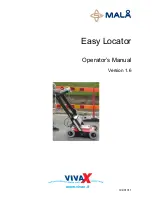
11
1. The charger was designed to fast charge the battery only
when the battery temperature is between 32˚F (0˚C) and
113˚F (45˚C). If the battery pack is too hot or too cold, the
charger will not fast charge the battery. (This may happen if
the battery pack is hot from heavy use). When the battery
temperature returns to between 32˚F (0˚C) and 113˚F
(45˚C), the charger will automatically begin charging.
2. A substantial drop in operating time per charge may mean
that the battery pack is nearing the end of its life and should
be replaced.
3. Remember to unplug charger during storage period.
4. If battery does not charge properly:
a. Check for voltage at outlet by plugging in some other
electrical device.
b. Check to see if outlet is connected to a light switch which
turns power “off” when lights are turned off.
c. Check battery pack terminals for dirt. Clean with cotton
swab and alcohol if necessary.
d. If you still do not get proper charging, take or send tool,
battery pack and charger to your local Bosch Service
Center. See “Tools, Electric” in the Yellow Pages for
names and addresses.
Note: Use of chargers or battery packs not sold by Bosch will
void the warranty.
Important Charging Notes
To power the unit
To Connect AC Power Plug
Plug the AC power cord of the unit into a standard AC
power outlet/socket with AC 120V/60Hz, it will switch to AC
once it is plugged in if it was running from a battery.
Note: The unit starts charging the battery automatically
once the unit is running by AC power.
To Operate by the Battery
Bosch battery pack supplies DC power to the unit in all
modes when the unit is disconnected from AC power. 12V
outlet power and 4 power outlets are not available until AC
cord is plugged into AC.
A
PROTECTIVE
COVER
INDICATOR
LIGHT
To reduce risk of electric shock, only plug
the unit into a Ground fault circuit
interrupter (GFCI) protected outlet when used in damp
locations. if a GFCI protected outlet is not available, use a
portable receptacle with built-in GFCI protection. Test GFCI
protected outlet according to instruction provided by GFCI
manufacturer. If the GFCI protected outlet does not pass
the GFCI testing, do not use that outlet. Only plug radio into
a functional GFCI protected outlet.
Use of the Convenient
4-way Outlets
The combined output rating of the four
AC outlets is 10A Max. To reduce the risk
of electric shock or fire hazard, do not overload the AC
outlets.
With the Unit plugged into AC power, perform the following
steps to use the convenient power outlets:
1. Lift up the protective cover to expose the AC power
outlets.
2. Plug into the outlet the desired AC appliance or power
tool.
3. Once you are done using the AC outlets on the unit,
insure that the protective covers properly close.
Do not use where water is likely to enter
unit. This device will not guard against
shock hazard from: 1. Defects or faults in the electrical
supply to the interrupter. 2. Personal contact with both
circuit conductors from the interrupter.
USE OF GFCI
(Ground fault circuit interruptor)
The GFCI helps protect you against hazardous electrical
shock that may be caused if your body becomes a path
through which electricity travels to ground. This could
happen when you touch a power tool that is "live" through a
faulty mechanism, dampness, worn insulation on the power
cord, etc. A shock may happen even if you are only
touching plumbing or another material that leads to ground.
When using a GFCI device you may still feel a shock, but
the GFCI is designed to cut off power quickly enough so
that a normal healthy adult will not experience serious
electrical injury.
GFCI's will NOT protect against:
1. Line-to-line shocks (of the type received when touching
metal inserted in both straight slots of a receptacle).
2. Current overloads or line-to-neutral short-circuit. THE
FUSE OR CIRCUIT BREAKER AT THE DISTRIBUTION
BOX OR PANEL MUST PROVIDE SUCH OVER-
CURRENT PROTECTION!
WARNING
!
WARNING
!
WARNING
!
WARNING
!
Summary of Contents for PB360S
Page 38: ...38 Notes ...
Page 39: ...Remarques Notas 39 ...












































